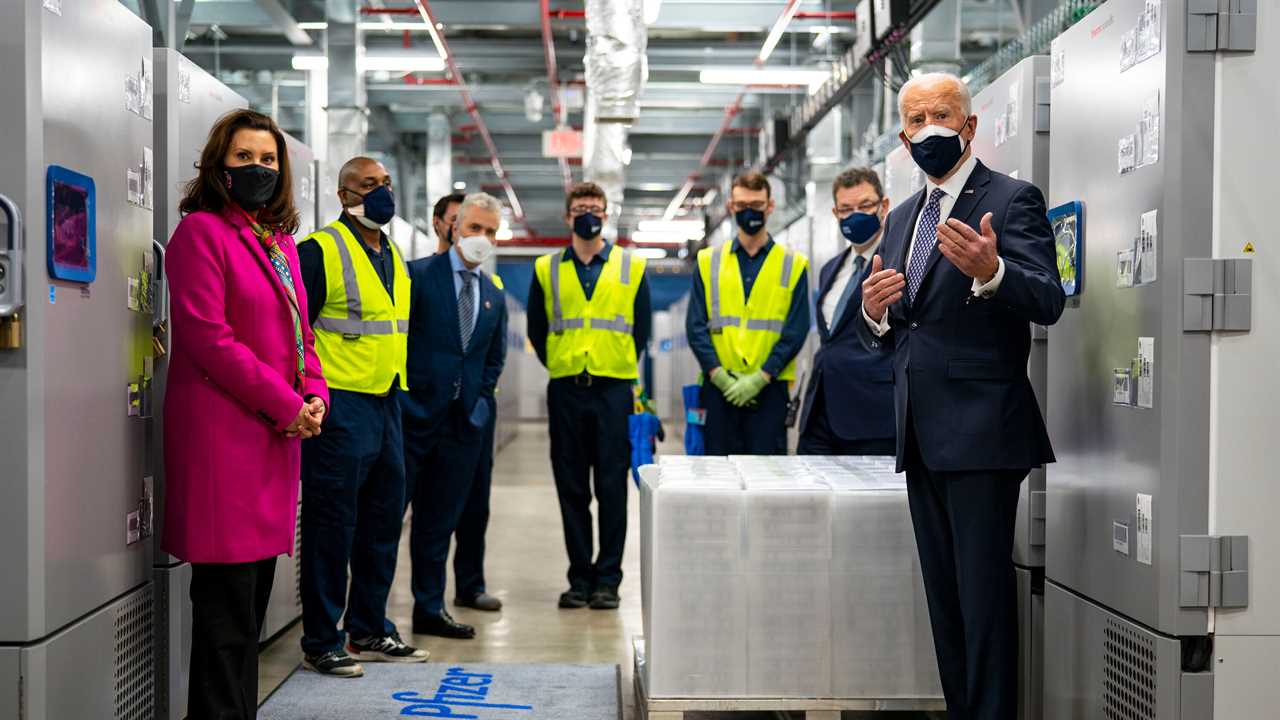
It has now been exactly 11 months to the day since California became the first state in the country to issue a mandatory stay-at-home order — and finally, experts say, it’s starting to feel as if the country is turning a corner in the pandemic.
This week, with vaccine production continuing to ramp up, President Biden declared that vaccines would be available for 300 million Americans “by the end of July” — enough to reach a critical mass. And today, as Biden headed to Michigan to tour a Pfizer vaccine plant, the Centers for Disease Control and Prevention released a report stating that the available vaccines were quite safe, with only minor side effects.
Biden struck a hopeful tone during his remarks at the plant, underlining the difficulties of rolling out a nationwide vaccination program but also ticking off a laundry list of goals that had been set and met over the past few weeks.
“I can’t give you a date when this crisis will end, but I can tell you we’re doing everything possible to have that day come sooner rather than later,” he said. “I believe we’ll be approaching normalcy by the end of this year and, God willing, this Christmas will be different than last. But I can’t make that commitment to you; there are other strains of the virus; we don’t know what could happen in terms of production rates. Things could change.”
For now, experts agree there is cause for optimism. “All of the indicators are pointing mostly in the right direction,” said Josh Michaud, associate director for global health policy at the Kaiser Family Foundation. “The case trajectories are looking good right now. All the case numbers are coming down.”
Now that former President Donald Trump’s impeachment trial has been put to bed, the spotlight has settled on the new administration — and there’s no greater political issue on Americans’ minds than how the government responds to the pandemic.
Biden had put coronavirus relief at the center of his campaign, and his promise of additional stimulus checks for Americans was seen as particularly crucial to the Democratic Senate candidates’ wins in Georgia last month.
Biden is working to deliver on his promises before voters lose faith — and he’s also facing down a stark deadline: Some key provisions in the latest round of economic relief, passed just before Biden took office, will run out in less than a month. If unaddressed, this would end federal supplements to unemployment benefits and cut back on aid to small businesses, among other things.
But Democrats are increasingly confident that if they can deliver boldly on coronavirus relief, and take credit for a relatively fast and effective distribution of the vaccine, they will be rewarded in the midterm elections in November 2022, as the G.O.P. struggles to regain its footing. Over two-thirds of Americans, including 68 percent of independents, said in a Quinnipiac University poll released this month that they supported passing the $1.9 trillion relief bill that Biden has proposed.
Latest Updates
- California’s governor sets aside vaccine doses for teachers.
- California’s small business owners, suffering from the lockdown, push to recall Governor Newsom.
- Biden says the United States could be ‘approaching normalcy by the end of this year.’
House Democrats today unveiled a nearly 600-page proposal for the legislation, and in his remarks this afternoon, the president virtually dared Republicans in Congress to oppose the bill. “Critics say that my plan is too big, that it costs $1.9 trillion,” Biden said. “Let me ask them: What would they have me cut? What would they have me leave out? Should we not invest $20 billion to vaccinate the nation? Should we not invest $290 million to extend unemployment insurance for the 11 million Americans who are unemployed, so they can get by?”
But there’s one big campaign promise that continues to be particularly thorny: the dilemma of how quickly to reopen schools. As he was careful to note this afternoon, those decisions will ultimately be made at the state and local levels, but Biden has stood by a promise to safely reopen most schools nationwide within the first 100 days of his presidency — meaning by late April.
The administration has struggled to decide where to put its own goal posts on this issue. At a CNN town-hall-style event this week in Wisconsin, Biden affirmed that the goal was to have schools open five days a week, contradicting a statement by his press secretary, Jen Psaki, who had said that schools that held in-person classes at least one day a week by the spring would be counted as meeting the president’s goal.






